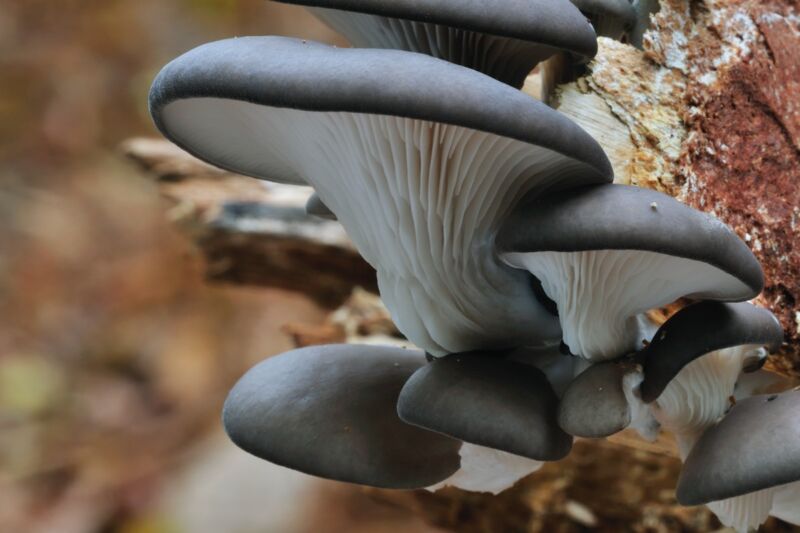January 18, 2023
A common ingredient in many different types of cuisine, oyster mushrooms (Pleurotus ostreatus) are praised for their delicate tastes and a fragrance that faintly resembles anise. Additionally, these cream-colored mushrooms are one of numerous varieties of carnivorous fungus that primarily feed on nematodes (roundworms). The mushrooms have developed a novel method of paralysing and killing their nematode prey: a toxin that, when released, kills most of the roundworms' cells within minutes. This toxin is found inside lollipop-like structures called toxocysts. A recent publication in the journal Science Advances describes the discovery of the precise volatile organic molecule that causes this effect.
Nematodes are a convenient source of protein for carnivorous fungi like the oyster mushroom because they are prevalent in soil. For hunting and devouring their prey, several methods have developed in different animals. For instance, oomycetes, which resemble fungi, release "hunting cells" to look for nematodes. Once discovered, they create cysts close to the anus or mouth of the roundworms before injecting themselves inside of them to target the internal organs. Another group of oomycetes injects the fungus spores into the worm to seal its doom by using cells that act as prey-seeking harpoons.
Other types of fungus create spores with grating designs like stilettos or stickles. The spores are ingested by the nematodes and then become stuck in the oesophagus where they puncture the worm's gut and begin to germinate. There are also death collars that detach when nematodes swim through them, injecting themselves into the worms, sticky branch-like structures that work like superglue, and perhaps a dozen or so fungal species use snares that tighten in less than a second, squeezing the nematodes to death.
These physical traps are avoided by the oyster mushroom in favour of a chemical process. P. ostreatus is a "wood rotter" that attacks dead trees, although wood contains little protein. The portion of the mushroom that penetrates the decaying wood are its long, branching filaments, or hyphae. The toxocysts live inside the hyphae. The toxocysts explode when worms come into contact with them, and the nematodes usually get paralysed and die within minutes. The hyphae develop into the nematode bodies after the prey has died, dissolving its contents and ingesting the slurry's nutrition.
2020 saw the testing of all 15 P. ostreatus species by a team of researchers from Academia Sinica in Taiwan, who discovered that all 15 were capable of producing poisonous drops when hungry. They examined 17 different nematode species as well and discovered that none could endure exposure to the toxin. The calcium that is held in animal muscles and released in response to nerve impulses may be the source of the problem, according to co-author Ching-Han Lee and colleagues. When nerve impulses cause the calcium stores to be refilled, the muscles relax.
The researchers carried out studies where the calcium in the worms could be seen, and they then observed how the worms responded when exposed to oyster mushroom toxocysts. They discovered that calcium had overflowed into the pharynx and head muscles of poisoned nematodes, and they claimed that calcium did not break down, causing extensive nerve and muscle cell death. They proposed that the first calcium response would be triggered by the poison, but that the mechanism by which the nematodes replenish their calcium supply would subsequently be jammed.
Lee et al. did remark that the chemical mechanism of the oyster mushroom was different from the nematicides currently employed to control nematode populations, but they were unable to pinpoint the precise toxins that were responsible for the impact. Lee and the other authors of the current study did just that using gas chromatography-mass spectrometry. The culture media and glass beads were the only components of the sample in the vial used for the experiment's initial testing. A second test was performed on a P. ostreatus vial sample that had been cultivated for two to three weeks. The third version tested a vial sample that contained both cultured P. ostreatus and glass beads, combining the prior two versions.
The offender is a volatile ketone by the name of 3-octanone, one of many naturally occurring VOCs that fungus employ for communication. It appears that 3-octanone also functions as a strong nematode-killing agent. Four different worm species experienced the characteristically large (and lethal) influx of calcium ions into their nerve and muscle cells after being exposed to 3-octanone. The authors claim that the dose is important. Slugs and snails are repulsed by low doses, but excessive doses are lethal. For nematodes, the same holds true. To cause the quick paralysis and extensive cell death, a high concentration of 3-octanone more than 50% is needed. The scientists also caused the fungus to undergo hundreds of random genetic alterations. For the worm Caenorhabditis elegans, the mutants that didn't produce toxocysts on their hyphae were no longer poisonous.
The scientists speculate that the reason oyster mushrooms developed such an odd method of killing nematodes is that decaying or dying trees contain very little nitrogen, and this method is a good way for the mushrooms to make up for that shortage. The toxocysts could potentially be used for defence. Having toxocysts that release poison gas on the hyphae might defend the fungus against such predators, as certain species of worm can puncture the fungal hyphae to suck out the cytoplasm.
Under the terms of a Creative Commons licence, this article has been taken from arstechnica. Go here to read the original article.










If you have any doubts, please let me know